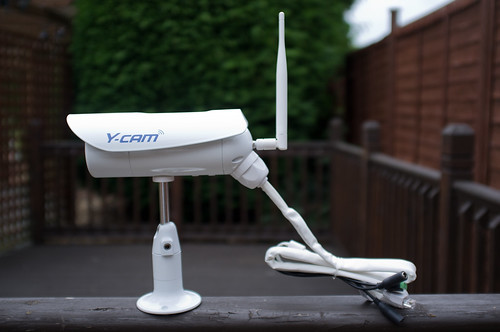IP Cameras are generally either for (a) indoor use, (b), outdoor use, or (c) both. Also, any of these types can be (a) WIRED, or (b) WIRELESS.
OUTDOOR use cameras are weatherproofed, and that capability will cost you. These have to be waterproof, UV resistant, wind resistant, and able to endure temperature swings. The wiring needs to be hidden or resistant to elements. The mounts tend to be sturdier. Some of the more expensive outdoor cameras even have built-in heaters for colder climes.
INDOOR cameras tend to be made of plastic, are lighter, less rugged, and are often less expensive than their outdoor cousins.
DUAL-USE cameras are actually outdoor cameras that can be ALSO used indoors. Presumably ALL outdoor cameras might be considered to meet this spec, but in reality that's impractical. For example, some DOME cameras (read about DOME cameras in a later entry, here) are specifically made to mount on a pole, and aside from a certain type of club (where in fact an IP Camera might be very popular!), most homes don't have poles indoors. Other outdoor cameras are bulky or unsightly for indoor use.
So generally you won't find a camera touted as *dual-use*. It would instead be an outdoor camera that you could bring indoors.
WIRELESS camera is a bit of a misnomer, since in truth, almost all IP cameras are wired to a power source (but send their data wirelessly to a router). Generally users choose wireless connection when they want mobility, such as for a tablet PC, a cellphone, laptop, etc. Yet many, perhaps even most IP cameras are in fixed locations, mitigating the typical wireless advantages. Yet wireless cameras are becoming common as wired are *yawn* old-school.
I believe most home users, including ME, choose wireless out of laziness, and the *coolness* of it. I even have one camera not more than 8 feet from a cat-V connection, yet it's wireless!
Wireless cameras present challenges. They are far more difficult to set up, and they tend to be less reliable than their wired cousins (note- most wireless cameras can optionally be set up as wired). Also, they are less secure, far more prone to interference, and transceive data at a much slower rate.
But despite all the drawbacks, wireless is THE WAY TO GO. In some locales, particularly outdoors, it's difficult to run CAT-V, or outside the range unless you add a repeater. And Cat-V may not cohabitate well with a 120v 60Hz adjacent wire, over a long run in conduit. Inductance would NOT be your friend :)
WIRED Cameras are common in the CCTV arena (see the next post for definitions), but not so common for networked cameras. They offer better speed, more stability, and more security, but all at the price of being tethered to a switch or router. And if you plan to install say 8 or more cameras, well most of us don't have that many open CAT-V ports.
Look at the next entry for a more detailed look at cameras types.



No comments:
Post a Comment